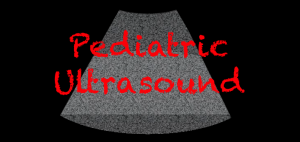Ultrasound Evaluation of Right Lower Quadrant Mass
Posted on: January 14, 2015, by : Jason Woods MD
A 5 year old previously healthy male presents to the ED for abdominal pain and fever. The pain reportedly began 6 weeks ago. The onset was sudden, focal in the RLQ, and was associated with persistent fevers to 102. He was seen by his PCP who initially diagnosed him with constipation, and started polyethylene glycol. His abdominal pain and fevers persisted, and he was missing several days of school per week due to pain. He developed pain in his lower back and bilateral legs for which he was seen again by his PCP 1 week ago. He was diagnosed with toxic synovitis and started scheduled ibuprofen. He presents to the ED today due to the development of new dysuria, pain with bowel movements, and 10 lbs. weight loss due to decreased appetite.
Vital Signs
T 38.9, HR 119, RR 18, BP 124/74, sats 100%
Reporting 6/10 abdominal pain.
Physical exam:
Gen: Awake, alert, in paint
HEENT: MMM, OP clear, EOMI,PERRL, neck with full ROM and no meningismus
Resp: CTAB, non-labored respirations
CV: regular rhythm, no murmur/rub/gallop, pulses 2+ x 4 extremities, capillary refill brisk
Abd: bowel sounds present, non-distended. Abdomen diffusely tender with greatest in RLQ. + involuntary guarding, + rebound, + pain with with standing. + psoas sign.
MSK: No joint tenderness or swelling, limited ROM of right hip secondary due to worsening of abdominal pain.
Neuro: CNII-XII intact, sensory and motor grossly intact
Labs significant for WBC 17.5 (80% segs, no bands) and a normal BMP and UA.
Bedside ultrasound was done and is pictured below.
This ultrasound clearly shows a well-circumscribed, thick-walled irregular complex fluid collection measuring ~4 cm in diameter. The contents have heterogeneous echo texture some septations, concerning for purulent material. Doppler revealed no flow within this mass. Appendix was not discretely identified.
Formal ultrasound confirmed the presence of a large RLQ abscess, likely from a prior ruptured appendix, and the patient was taken for IR guided drainage. 20 ml of purulent material was removed. He was discharged from the hospital on several weeks of IV antibiotics.
